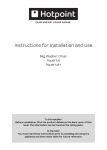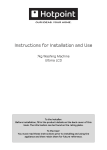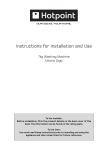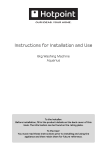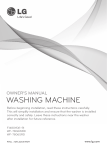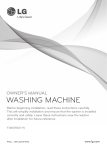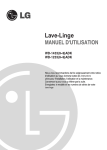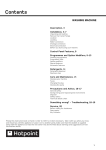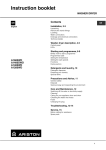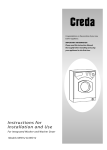Download Horizon Fitness 3.2T Treadmill User Manual
Transcript
Instructions for Installation and Use 6kg Washer Dryer Ultima To the Installer: Before installation, fill in the product details on the back cover of this book. The information can be found on the rating plate. To the User: You must read these instructions prior to installing and using the appliance and then retain them for future reference. Description GB Dispenser drawer Control panel (● Varies by Model) ● Please record the Model number and Serial number of your machine on the back cover of this book for future reference. - The Serial number can be found on the inside door trim. Interlocking door and release lever. Front adjustable feet Drainage hose Cold water inlet points and attached fill hoses (blue connectors) Mains cable ! DO NOT remove either of the attached fill hoses OR the ‘Y’ piece connector, even if you have both Hot and Cold water supplies (see page 7). Hooked end support Two transit fixings ! BOTH must be removed BEFORE you use your machine (see page 6). Plumbing indicator line Rating plate ‘Y’ piece connector Back feet 2 Contents WASHER DRYER GB Description Description, 2 Wash Labels Explained, 4 Installation, 5-8 Contents Unpacking Remove the transit fixings Location Levelling Water connection Drainage connection Electrical connection Before you start using your machine Wash Labels Explained Control Panel Features, 9 Installation Programmes and Option Modifiers, 10-16 Control Panel Features Starting a wash and dry programme Drying Programme table Special features Option modifiers Detergents and Laundry, 17 Detergent dispenser Programmes Something and Option Detergents Care and Precautions Wrong Modifiers and Laundry Maintenance and Advice Troubleshooting Care and Maintenance, 18 Cleaning your machine Fuses Changing the plug Precautions and Advice, 19-20 General safety Saving energy and respecting the environment Disposal Safety advice Technical details chart Something Wrong? - Troubleshooting, 21-23 Service, 24 Before calling for assistance Spare parts Key Contacts ! Keep this instruction book on hand in order to refer to it when necessary. Take it with you when you move, and should you sell this appliance or pass it on to another party, make sure that this booklet is supplied along with the appliance so that the new owner may be informed about warnings and suggestions on how the machine works. Service 3 Wash Labels Explained GB The number inside the wash tub shows the maximum water temperature, in ˚C. If there are no bars, the garment can be spun and rinsed as normal. One bar indicates a reduced spin speed programme should be used. Two bars mean the clothes need a mild wash action, but can be spun and rinsed normally. Such items should not be wrung out by hand. If the tub contains a hand, wash the item on a Hand Wash programme. A triangle means that you can safely use a cold, dilute solution of bleach. A triangle with a cross over it means the item cannot be bleached. A circle inside a square means you can tumble dry the garment. The dots indicate temperature - one dot for lower heat. - two dots for higher heat. A cross over this symbol shows you should not tumble dry the garment. A circle means the garment is suitable for dry-cleaning. A letter inside the circle is to tell the dry-cleaner which chemical wash and method to use. 4 Installation 4. Remove the polystyrene base. GB Description ! Read these instructions carefully: the following pages contain important information on installation and suggestions on how the appliance works. Unpacking Installation ! IMPORTANT check when unpacking your machine: ! This is a part of the polystyrene base and should have stayed intact when you removed the base. ! If it has broken off and is still in the machine... remove it... while the machine is still laying on its side on the top cap. Wash Labels Explained 2. Lift off the polystyrene top cap and remove the four corner posts. Contents 1. Using scissors, cut carefully along one corner post to remove the film. Control Panel Features 5. Stand the machine upright. Programmes Something Detergents Precautions Care and and Option Wrong and Laundry Maintenance and Advice Troubleshooting Modifiers ! We recommend that a second person helps to raise and lower the machine. 3. Carefully lay the left side of the machine down onto the top cap. ! We recommend that a second person helps to raise and lower the machine. ! Continue to read the rest of these instructions carefully; the following pages contain important information on installation and troubleshooting. ! Protect the environment - please dispose of the packaging material carefully and considerately. Service 5 Installation GB Remove the transit fixings 3. Hold, slide sideways and pull to remove. IMPORTANT: Follow these instructions to remove the TWO transit fixings (see Description for location). ! Situated one either side of the rear panel, BOTH transit bolts MUST be removed before use. 4. For safety, insert one of the the plastic covers (supplied with your machine) over the hole. ! Repeat steps 1 to 4 to remove the second transit bolt. Location of transit bolts. ! Packaging materials are not children's toys. ! Failure to do so may cause damage to your machine. Location ! It is important the TWO transit fixings come out intact. ! Be sure to remove TWO bolts, TWO washers, TWO rubber grommets and TWO nylon spacers (see pic). Where you install your machine will affect its performance: ! For your safety and to comply with electrical regulations, seek professional advice if you want to install your machine in a bath or shower room. ● 1. Unscrew the bolt using a 13mm spanner. ● ● 2. STOP when 3 threads can be seen. Make sure that the electrical socket and water taps are easily accessible. You should switch off the machine’s electrical and water supplies when you are not using it for extended periods. Make sure that you allow enough space for the machine. Select a space at least 60cm wide, 60cm deep and 85cm high. Also leave enough space to open the door fully, so that you can load and unload it easily. Where possible, the machine should be positioned on a solid floor to minimise vibration. ! Take care when you move the machine not to rip any floor coverings. The weight of the machine may cause indentations in some floor coverings. Did you know?... ● ● ● ● 6 ...the transit fixings are fitted to ensure that your machine is undamaged during delivery. ...both of the transit fixings MUST BE removed before using the machine, be sure to remove TWO bolts, TWO washers, TWO rubber grommets and TWO nylon spacers, not doing so will lead to excessive vibration, movement of the machine and could eventually lead to internal damage. ...the majority of problems with noisy machines are due to the transit fixings not being removed. ...you will be charged for a service engineers visit if a problem with your machine is caused by incorrect installation or misuse. Installation Levelling Benefits of cold fill ● ● ● COLD WATER SUPPLY ‘Y’ piece connector Cold water fill hose (Blue Connectors) ● Programmes Something Detergents Precautions Care and and Option Wrong and Laundry Maintenance and Advice Troubleshooting Modifiers Connecting the cold water inlet hoses with the ‘Y’ piece connector. ! Remember: please use the new hoses supplied, fitted to the machine. Old hoses may cause leaks due to worn out washers or may be split due to water pressure. ! Remember: This is a cold-fill machine... BOTH fill hoses (blue connectors) fitted to the rear of the machine MUST be connected to the COLD water supply (via the ‘Y’ piece connector). ! Before making connections to the cold water supply, allow the water to run freely from the supply tap until it is perfectly clear. Control Panel Features ● Modern detergents are designed to give the best cleaning results at low temperatures. Biological detergents contain enzymes which are active between 30˚C and 53˚C, giving greater results at lower temperatures. Cold water relaxes fabrics, whilst hot water can seal in stains. Improved stain removal with cold water. The most commonly used programme at present is 40˚C, which will take on cold water even if hot and cold were available. You can heat the water required to finish the wash cycle, which makes it more economical than taking water heated in a tank by an immersion heater or gas boiler. Installation Water Connection Wash Labels Explained ! If it is placed on a fitted or loose carpet, adjust the feet in such a way as to allow enough room for ventilation beneath the machine. ! We recommend fitting a 3/4" sealing cap to the hot water supply tap (if present), to ensure there are no leaks. Sealing caps can be purchased from Hotpoint Service on 08709 077 077 or all good DIY and Plumbing outlets. Contents 1. Move your machine into its final location, taking care not to trap or kink the hoses. 2. Turn one or both front feet anti-clockwise by hand until the feet cannot be turned any more. When adjusting the feet, use a spirit level to check the machine stands level, from side to side and from front to back. The spring on each foot will stop them coming loose. GB Description Your machine will be noisy if the two front feet are not adjusted so that the machine stands firm and level. ! The machine must be levelled from side to side and from front to back. 1. Screw the ‘Y’ piece connector onto the cold water supply until tight. 2. Fit a 3/4" sealing cap to the hot water supply, to prevent unused supply leaking. 3. Turn ON the COLD water supply tap and check for leaks, tighten if necessary. 4. Leave the unused HOT water supply turned OFF. Hints and tips ! Make sure there are no kinks or bends in the hose. ! The water pressure at the supply tap must be within the values indicated in the Technical Details table (see page 20). ! If the water inlet hoses are not long enough, you can purchase an extended hose from Hotpoint Service on 08709 077 077. ! Always use a new inlet hose. ! Check the water inlet hose at least once a year, replace if cracked as worn hoses could split under water pressure. ! Turn on the water supply and check that the connections do not leak. If there is a leak, turn off the water supply, disconnect the hoses and check that the sealing washers are in place. Refit the hoses and turn on the water supply. Did you know?... ● ● Service ● ...the most common cause of problems with water connection is that the customer has not turned the supply tap on.. ...it is very important to ensure that your hoses or cables are not kinked or squashed when the machine is pushed back into its location, as this can lead to your machine failing to fill or empty the water. ...the majority of problems with noisy machines are due to the feet not being adjusted correctly to level the machine. 7 Installation GB Drainage Connection Electrical connections ! Although you may need to move the hooked end support along the grey drainage hose, DO NOT remove it. Before plugging the appliance into the mains socket, make sure that: ● the socket is earthed and in compliance with the applicable law. ● the socket is able to sustain the appliances maximum power load indicated in the Technical Details table (see page 20). ● the supply voltage is included within the values indicated in the Technical Details table (see page 20). ● the socket is compatible with the machines plug. If this is not the case, replace the socket or the plug, ensuring a 13A fuse is fitted. ! Whichever drainage method you use, make sure that the hooked end support is fixed level to, or above the ‘Plumbing Indicator Line’ (see Description page 2). We recommend one of the following: Standpipe method: 1. Make sure the standpipe height is a minimum 500mm up to a maximum 1200mm from the floor. 2. Insert the drainage hose approximately 100mm into the standpipe. Hooked end support minimum: 500mm maximum: 1200mm Under sink method: 1. Cut off the blocked end of the under sink drainage unit, or remove the blanking plug if fitted. 2. Fix the hooked end support a minimum of 800mm from the floor. 3. Use a hose clip (eg. a jubilee clip) to securely attach the grey drainage hose end to the under sink drainage unit. ! The machine should not be installed in an outdoor environment, not even when the area is sheltered, because it may be very dangerous to leave it exposed to rain and thunderstorms. ! When the machine is installed, the mains socket must be within easy reach and should be connected to a suitable electrical supply. ! Do not use extensions or multiple sockets. ! The power supply cable must never be bent or dangerously compressed. ! The power supply cable must only be replaced by an authorised serviceman. ! The company denies all liability if and when these standards are not respected. Before you start using your machine Hose clip minimum: 800mm from floor The first wash cycle Once the appliance has been installed and before you use it for the first time, run a wash cycle without detergent and no laundry. This will check your installation, connections and drainage and will thoroughly clean the interior before you carry out an actual wash programme on your laundry. This will take approximately 21/2 hours to complete. ! Run the 95˚ White Cotton programme 'B', without laundry and without detergent. ! During this cycle check for any leaks from under the machine. If present ensure all hoses are securely tightened. Did you know?... ● ● ● ● 8 ...it is very important to ensure that your hoses or cables are not kinked or squashed as this can lead to your machine failing to fill or empty the water. ...it is very important to respect the dimensions given within the drainage connection methods (see above). ...if using the undersink drainage method remember to cut off the blocked end, or remove the blanking plug. ...you will be charged for a service engineers visit if a problem with your machine is caused by incorrect installation or misuse. Control Panel Features Ultima GB On/Off light Description LCD display Status indicator lights ON/OFF Pause button Contents START/CANCEL button Programme selector buttons Installation Option buttons Wash Labels Explained Detergent dispenser drawer Control Panel Features Ultima control panel features Option buttons: To select the options available (see Programme Table and Option Modifiers). ● LCD display: Shows all information relating to your programme selections: wash temperature and spin speed, chosen options, along with time remaining. It will also indicate if the door is locked (when ‘keyhole’ symbol lit, the door cannot be opened) and the stage of the programme the machine has reached (wash, rinse or spin). ● ON/OFF Pause button: To turn the washing machine on and off. If pressed when the machine is running the programme will be paused, press again and the machine will restart. ● ON/OFF light: Shows that the machine is in use or is on ready for you to select a programme. ● START/CANCEL button: To start the selected programme - or to cancel a running programme, if incorrect settings were selected. ● Programme selector buttons: To select the programme you require. Press the button the required number of times to select the programme you want (For more information please see ‘Starting a wash programme’ section, Programmes and Option Modifiers). Programmes Something Detergents Precautions Care and and Option Wrong and Laundry Maintenance and Advice Troubleshooting Modifiers ● Service 9 Starting a Programme GB Starting a typical wash and dry programme 1. Switch the machine on by pressing the ON/OFF Pause button. 2. Sort your laundry into groups by washcare labels. Load the machine. Close the machine door by pushing it until it clicks. 3. Add detergent and fabric conditioner to the dispenser drawer. 9. In addition to showing you all information relating to your programme selections, the LCD display will show you the stage of a programme in progress, the time remaining until the end of a programme in hours and minutes (counting down each minute) and the door lock status. - If ‘Time Delay’ option was selected the display will show the time remaining until the start of the wash programme in hours (counting down each hour). 10. Start the programme by pressing the START/CANCEL button for at least 3 seconds. ! The ‘Door Locked’ indicator, will light up. ! Refer to detergent manufacturer’s dosage instructions. 4. Select the programme: - press the programme selector button the required number of times (see Programme Table). ! The LCD display will change on each press to show the temperature of the selected programme. 5. Select any optional wash feature(s) (see Option Modifiers) you require by pressing the appropriate button(s). - Indicator lights on the LCD display will show what you have chosen. 6. Reduce the wash temperature of your selected programme: - Press the Temp button, each press will reduce the wash temperature by 5˚C. The new temperature will be shown in the LCD display. 7. Reduce the spin speed of your selected programme: - Press the Spin button, each press will reduce the spin speed. The new spin speed will be shown in the LCD display. 8. Select drying time or level choose either: ● Auto ‘Sensor Dry’ - Press the Sensor Dry button once, ‘Auto’ will appear in the display. ● Timed drying - Press the Timed button, until the required time is shown in the display. 10 ● To stop/change a programme once the machine has started: - Press the START/CANCEL button until a beep is heard. - The machine will start to empty. When the machine has finished emptying: - Selector the new programme required (you may need to add detergent). - Press the START/CANCEL button to start the new programme. 11.During the programme, the status indicator lights will show you what stage in the programme the machine has reached (wash, rinse, spin, dry). 12. A short time after the programme has finished the ‘Door Locked’ indicator will go out and you can open the machine door. 13. Switch the machine off by pressing the ON/OFF Pause button. ! Do not allow children to play with the machine or tamper with the controls. ! Do not overload the machine. This may damage the laundry and reduce the quality of the wash. The maximum load (Cotton) is 6kg WASH / 5kg DRY. ! Do not try to open the dispenser drawer during any programme. ! Do not try to open the machine door when the ‘Door Locked’ indicator is lit. Drying Setting drying programmes GB 1. 4. 5. *for smaller loads reduce the drying time accordingly. Programme Dry Weight load Heat setting Cottons Synthetics Time Setting* (approx) B,C,D,E & F 5kg max. High Heat max. 3 hours G&K 3kg max. Low Heat max. 2 hours Control Panel Features Fabric Installation Drying table Wash Labels Explained 6. Remove the wet laundry and in drum dosing ball (if used) until the correct ‘Drying Weight Load’ (see Drying table, below) is left in the drum. Close the door until it clicks shut. Press the ON/OFF Pause button to turn the machine on (‘On’ shows on the display). If drying cottons: select HIGH HEAT (see Option modifiers) by pressing the Drying Heat option button: - ‘High Heat’ will illuminate on the display. Set the required drying time or autodry option (see Drying options, below). When all selections have been made press the START/CANCEL button. - The ‘Door Locked’ indicator light will illuminate on the display showing the door is locked. A short time after the programme has finished the ‘Door locked’ indicator light will go out and the door can be opened. Contents 2. 3. Description Independent drying only programme: Programmes Something Detergents Precautions Care and and Option Wrong and Laundry Maintenance and Advice Troubleshooting Modifiers ! It is recommended that you separate your drying loads into similar fabric types, as this will increase the drying efficiency. Drying options ● Timed Drying programmes: Where you can select the length of the drying time suitable for your load. - Press the Timed button twice and ‘3:00’ will appear on the display, indicating 3 hours drying time. - Each subsequent press of the Timed button will reduce the drying time shown on the display in 30 minute increments until ‘0:30’ (30 minutes) is displayed. - Pressing the Timed button again after ‘0:30’ is displayed cancels the drying programme, ‘Off’ will appear on the display, no drying programme is selected. ● Auto Drying programme ‘Sensor Dry’: When selected the machine will automatically sense when the laundry is dry and switch off. - Press the Sensor Dry button to select the dryness level required (see Table below): Press button Display window shows Fabric Once Cupboard Dry Twice Hanger Dry Three times Maximum dry weight load 1kg - 5kg Iron Dry Service ! Remember, with both the ‘Timed Drying’ programme and the Auto ‘Sensor Dry’ programme, the Drying Heat option needs to be selected if drying non-delicate loads (eg. Cottons). 11 Drying GB Important information Operating the machine ! To improve the life expectancy of your machine, it is recommended that you do not stop or cancel your programme during the drying cycle. ! It is recommended that you allow the programme to complete its full cycle, which includes completing the ‘cool tumble’. ! A 20 minute ‘cool tumble’ is included at the end of drying, allowing fabrics to cool down, minimising creasing - The load may still be warm when removed from the machine. ! If your machine is not permanently plumbed in, turn on the cold water supply and hook the drain hose over the sink to enable the condensing action to work. ! The dryer is intended for use only where water is used for the cleaning process. ! Be careful not to touch the drum at the top, as this area does get hot during drying. ! On no account should liquid fabric conditioner be added during the drying process. ! Misuse of the dryer may create a fire hazard. ! Select HIGH heat by pressing the ‘Drying Heat’ option button (‘High Heat’ will show in Display). - If this option is not selected the programme will automatically default to low heat (‘Low Heat’ will show in Display). - If High Heat is selected, pressing the ‘Drying Heat’ option button again will select Low Heat. ! A spin cycle may be carried out during the drying programme. ! Your machine is fitted with a revolutionary self-clean filter, which will flush with water during drying - therefore you may hear water entering the machine during the drying cycle. Drycare tips Items not suitable for tumble drying: ● ● ● ● ● ● 12 Garments with the ITCL code DO NOT TUMBLE DRY. Woollens. Large, bulky items eg. quilts, bedspreads, pillows etc... expand when dry, preventing air flow through the machine. Items containing plastic film, foam rubber or rubber like materials eg. pillows, cushions, PVC rainwear or inflammable articles which contain inflammable substances eg. towels contaminated with hair lacquer, Fibreglass (eg. some types of curtains). Items which have been dry cleaned. THREE TIMES 60 60 40 50 - 40 40 - 40 - - 30 - 30 H - - - - 3 4 5 6 7 8 9 10 11 R&S R&S FS SS For hard wearing heat resistant cotton and linen. An intensive cleaning programme for heavily soiled hard wearing fabrics. An intensive cleaning, energy efficient cycle using the maximum load capacity. A fast cycle for lightly soiled heat resistant cotton and linen fabrics. A less energy efficient intensive 40˚C cycle for more stubborn soiling. A cycle designed to wash a variety of man-made fibres and fibre mixtures. A cycle designed to wash a variety of man-made fibres and fibre mixtures. A special cycle for Hand Wash wool that will not shrink your garments exclusively approved by Woolmark. For silk garments labelled as machine washable. Hygienic White Cotton Superwash Colourfast Cotton Standard Colourfast Cotton (IEC 60456*) Fast Wash Colourfast Cotton Intensive Non Colourfast Cotton Man-made fibres Coloured Synthetics & Acrylics Man-made fibres Coloured Synthetics & Acrylics Gold Woolmark Approved Handwash Wool Machine Washable Silk This partial programme completes two full rinses and then a fast spin. This partial programme completes two full rinses and then a slow spin. This partial programme completes the maximum speed final spin. This partial programme completes the intermediate speed final spin. This draining programme ensures the appliance is emptied of water. Rinse & Fast Spin Cotton Rinse & Slow Spin Mixed Fast Spin Cotton Slow Spin Delicates Pump Out All FOUR TIMES Press START/CANCEL button - - - - - Normal Light Normal Normal Normal Normal Heavy Light Normal to Heavy Heavy Normal Soil Level - 800 Max 800 800 400 800 800 600 800 800 Max Max Max Max Max Spin Speed - Time Delay Time Delay Reduce Creases, Rinse Hold, Mini Load, Time Delay Reduce Creases, Rinse Hold, Mini Load Time Delay Rinse Hold, Time Delay Time Delay Pre Wash, Rinse Hold, Time Delay Time Delay Pre Wash, Reduce Creases, Rinse Hold, Mini Load, Time Delay, Time Saver Pre Wash, Reduce Creases, Rinse Hold, Mini Load, Time Delay, Time Saver Pre Wash, Reduce Creases, Rinse Hold, Mini Load, Time Delay, Time Saver Reduce Creases, Rinse Hold, Time Delay Pre Wash, Reduce Creases, Rinse Hold, Mini Load, Time Delay, Time Saver Rinse Hold, Time Delay Pre Wash, Rinse Hold, Mini Load, Time Delay, Time Saver Available Recommended Options Detergent Programmes Something Detergents Precautions Care and and Option Wrong and Laundry Maintenance and Advice Troubleshooting Modifiers 6 6 1 4 6 2 4 2 Control Panel Features Bath Towels SYNTHETIC Shirts = 3kg Blouses Set of Pyjamas Items of Underwear Pillow Cases Installation Children’s Dresses Shirts Blouses Set of Pyjamas Items of Underwear Wash Labels Explained 2 4 4 1 4 3 5 6 2 4 - - - - - Ariel Colour Liquid Ariel Colour Liquid Dreft Dreft Ariel Colour Ariel Colour Ariel Colour Ariel Colour Ariel Colour Ariel Colour Ariel Bio Powder / Tablets Children’s Dresses Shirts Blouses Set of Pyjamas Items of Underwear Contents Bath Towels SYNTHETIC Hand Towel = 6kg Shirts Blouses Set of Pyjamas Items of Underwear COTTON 2 = 5kg 6 0 : 02 0 : 12 0 : 15 0 : 20 0 : 25 0 : 50 0 : 30 0 : 55 0 : 50 1 : 05 1 : 15 1 : 45 1 : 00 2 : 00 2 : 20 2 : 30 Approximate Programme Time (h : min) COTTON 2 = 6kg 1 6 3 6 3 6 4 3 3 1 3 3 6 5 6 6 6 Max Load (kg) Two examples of maximum DRYING loads for different fabric: - - - - - 25 30 30 40 30 40 40 60 60 60 95 Temp (˚C) Two examples of maximum WASH loads for different fabric: TWICE ONCE TWICE A gentle cycle for delicate items labelled as Hand Wash only. Fast Wash A very short refresh programme for lightly soiled mixed Mixed (not Wool/Silk/Handwash) fabrics. Description Programme Type / Fabric *Programme setting for test in accordance with IEC 60456 and EN 60456 Description Service Handwash Delicates (not Wool/Silk) TWICE ONCE ONCE ONCE TWICE ONCE ONCE TWICE ONCE 60 2 THREE TIMES P 1 Label Programme Selector Button Programme Table Programme Table Programme Table *Programme setting for test in accordance with IEC 50229 and EN 50229 GB 13 Option Modifiers and Special Features GB Special features ! Not all special features can be used on all programmes - (see Programme Table for option availability). ● Fast Wash: The Fast Wash programmes are designed for lightly soiled loads delivering quick results for smaller loads, using less energy. For loads with stains or increased soil levels which require deeper cleaning, use the standard or intensive wash cycles. ● Wash & Dry: On most programmes a wash cycle can be immediately followed by a drying cycle. To select this simply select the desired wash programme and then select a drying time or an auto dryness level and the appropriate temperature for the drying cycle (default is LOW heat, press the Drying Heat option button for cottons). Press the START/CANCEL button and the wash cycle will start and when complete, the drying cycle will automatically commence. Note: The maximum capacity for a Wash & Dry load is: - Cottons 5kg - Synthetics 3kg ● Handwash: A gentle action programme for delicate items and items labelled as hand wash only. Not for Wool or Silk garments (use the special programmes for those materials). ● Handwash Wool Approved: The wool wash cycle on Hotpoint machines has been tested and approved by the Woolmark Company for washing garments labelled as ‘hand wash’, provided that the ‘garments’ are washed in accordance to the instructions issued by the manufacturer of this machine. - Select the wool programme (see Programme Table and Option Modifiers). ! We recommend using a wool wash liquid when using Wool programmes. ● Super Silent Wash: Using the latest brush-less electric motors and damper technology the noise levels during the washing phase are significantly lower than a conventional machine. ● LCD Display Shows all information relating to your programme selections. Also indicating the stage of a programme in progress. If Time Delay is selected, this shows the time remaining until the start of the wash programme in hours – counting down each hour. It also displays which option modifiers have been selected, the door lock status and the time to end of the wash programme in hours and minutes counting down each minute. ! Please note time can go up as well as down depending on load absorbency, load size and water temperature. Note: We recommend that if you use colour catcher sheets in your appliance that these only be used inside a wash bag, as otherwise they can affect the performance of your machine. Did you know?… ● ● ● 14 … when an option button is selected the corresponding light is illuminated. … if the option selected is incompatible with the programme selected, the button will flash and the option will not be enabled. … if you set an option that is incompatible with an option selected previously, only the last option selected will be enabled. Option Modifiers and Special Features Option modifiers GB Description ! Not all options can be used on all programmes - (see Programme Table for option availability). ● Mini Load: Use this option for smaller loads less than the capacity listed for the material and programme type (see Programme Table). This option reduces water consumption and washing time, saving energy when washing smaller loads. ● Time Delay: Use this option to delay the programme start by up to 24 hours. The LCD display will show the delay chosen. Each press of the button increases the Time Delay in increments of 1 hour. If you press the button again after 24 shows on the display the machine will reset the Time Delay and show ‘OFF’ on the display, pressing the button after this will start the Time Delay selection from 1 hour. Once the countdown reaches zero the programme will start. ● Variable Temperature: Use this option to reduce the wash temperature below the maximum for the programme you have chosen. - Each press of the Temp button will reduce the wash temperature by 5˚C. The new wash temperature will be shown on the display. If you press again after ‘OFF’ has been displayed, the machine will revert to the original higher temperature. ● Variable Spin Speed: Use this option to reduce the spin speed below the maximum for the programme you have chosen. - Each press of the Spin button will reduce the spin speed. The new spin speed will be shown on the display. If you press again after ‘OFF’ has been displayed, the machine will revert to the original higher spin speed. ● Pre Wash: Use this option to add a short wash cycle, at 30˚C before the selected wash programme starts. It is used to loosen heavy soil deposits on laundry. Press the Pre Wash button once to select this option, press again to cancel. It is recommended that detergent is also added to the Prewash compartment. ● Child Lock: Select this option to disable all buttons so no programme and option selections can be altered. Press the Child Lock option button and the option light will illuminate on the LCD display above the button. Once Child Lock is selected it remains activated even when the machine is switched off. If power is interrupted at any time pressing any button will reactivate the Child Lock feature. If Child Lock is activated and any control buttons are pressed the option light will flash: no alterations to the settings will be allowed. Press and hold the Child Lock option button for 2 seconds to cancel, the option light will go out. Service Rinse Hold: Selecting this option will pause the cycle in the final rinse with the fabric conditioner keeping the laundry fresh until you are ready to complete the programme. The Rinse Hold light will flash to indicate the cycle is paused. The machine will stay in this state, tumbling the load occasionally until either the START/CANCEL button is pressed or the Rinse Hold button is pressed again to continue the cycle. Programmes Something Detergents Precautions Care and and Option Wrong and Laundry Maintenance and Advice Troubleshooting Modifiers ● Control Panel Features Reduced Creases: Selecting this option will run the wash programme with a more gentle action and lower spin speed, in addition to carrying out an additional rinse to ensure your laundry has fewer creases and will require less ironing. Installation ● Wash Labels Explained Time Saver: Use this option to reduce the time of a wash programme. Press the timer Saver button, once, before the wash programme is started. Contents ● continued... 15 Option Modifiers and Special Features GB Option modifiers ● Drying Heat: - This control option can be used to select High Heat for drying. High heat (for drying cottons) can be selected by pressing the ‘Drying Heat’ button. The display window will show High Heat or Low Heat. If high heat is not selected the programme will default to a low heat setting. ● Timed Drying: - This control option can be used to select a time for drying. The time for drying will be illuminated in the display window when you press the ‘Timed’ button. This is based on time from 0 minutes to 180 minutes. By pressing the ‘Timed’ button again you will hear a bleep and the time will have been reduced from 180 minutes to 150 minutes. Keep pressing the button and you will see the time reduce in steps, down to ‘OFF’. ● Sensor Drying: - This control option can be used to select one of three levels of sensor drying. The sensor level for drying will be illuminated in the display window when you press the ‘Sensor Dry’ button: Level one is ‘Cupboard Dry’ and should be used if you want laundry to be very dry. This is recommended for items such as towels and bathrobes. Level two is ‘Hanger Dry’ and should be used if you want to dry items ready to put away. Level three is “Iron Dry’ and should be used if you want to dry items to be slightly damp, for ease of ironing. ● To select a Wash and Dry programme: Select a wash programme, then a drying programme by following the above steps. Wash and Dry is not available with the 25˚C Handwash, Wool, 30˚C Silks and Drain programmes. Automatic features Unbalanced load detection The machine has an inbuilt feature to prevent it from spinning too fast with an unbalanced load. When an unbalanced load is detected, the machine will attempt to redistribute the load in order to balance it evenly to achieve full spin speed. If this is not possible and an unbalanced load remains the spin speed will be reduced, depending on the amount of unbalance detected. This is to prevent the machine from damaging itself or its surroundings and to prevent excessive noise from the machine. ! If the spin result is unsatisfactory following a reduced spin speed attempt to rectify the unbalanced load, then on completion of the programme the load can be redistributed evenly in the drum by hand. Select a spin cycle. Note: Do not attempt to spin heavy or absorbent single items as the machine cannot distribute these evenly. If you need to wash a single item you will need to add some other items as ballast to allow the machine to distribute the load evenly throughout the drum. No water detection The machine will automatically detect if it cannot take in water and will notify you by flashing the ‘tap’ icon and showing ‘H20’ on the LCD display. If this occurs please check the appliance is plumbed in correctly, with both fill hoses fitted to the cold water supply using the ‘Y’ piece connector (see Installation ‘Water connection’). Energy saving and water levels Modern machines are designed to be as environmentally friendly as possible. To achieve this water levels are kept to a minimum to ensure they are economic and use the lowest energy possible. Unlike older appliances you will not see high water levels in the drum during washing. ! We recommend always washing as close to a full load as possible (see Programmes Table for the maximum load size of your selected programme). 16 Detergents and Laundry Detergent dispenser Washcare Tips ● Grate Drawer release catch ● Fabric conditioner compartment. Maximum: 120ml Adding fabric conditioner Pour the recommended amount of fabric conditioner into the compartment. Do not exceed the maximum fill line. Pre-Wash When selecting prewash, add detergent to both the pre-wash and the main wash compartments. Do not use the machine if the item to be washed does not have a wash label. Before washing laundry we recommend you: ● ● ● Pre-treat awkward stains with washable treatments. Do not wash any items that have previously been treated with solvents. Close zips, fasten belts, tie strings and close press studs to prevent tangling. Empty all objects from pockets as they may damage the laundry and the machine. Programmes Something Detergents Precautions Care and and Option Wrong and Laundry Maintenance and Advice Troubleshooting Modifiers Dispensing liquid detergent We recommend the use of a detergent dosing ball, as provided by your detergent manufacturer. ● Control Panel Features Dispensing tablets Tablets can be dispensed via the machine drum or via the dispenser drawer. ! Please CHECK the detergent pack for dispensing instructions. ! Incorrect use can damage your laundry. ! Remember you will be charged for a service engineers visit resulting from a detached bra wire. Installation Dispensing powder detergent To achieve the best wash results the manufacturer’s recommended amount of detergent should be measured and added to the main detergent compartment. Wash Labels Explained Main wash detergent compartment. Maximum: 400ml powder or 200ml liquid Contents Pre-wash detergent compartment. Maximum: 200ml powder or 100ml liquid DO NOT overload or underload the machine (see the Programme Table for maximum load), in addition to reducing the quality of the wash this may also damage your laundry and the machine, whilst causing the machine to become unstable and noisy. We strongly recommend that you DO NOT wash underwired bras in this machine. Should the wires become detached it could cause damage to your laundry and the machine. If the washcare label states that the bra is machine washable, then we advise placing it in a sealed pillow case or a similar washbag. Description ! Do not put any items into the drawer, other than detergents designed to be released from the drawer, as they may cause damage or blockage. GB ! Remember you will be charged for a service engineers visit to rectify malfunction resulting from objects such as coins, pens, hair grips etc. falling from pockets. ● ● ● ● Limit the size of absorbent loads ie. towels, to half loads to give good washing and rinsing results. Place small items in a wash bag. Always follow the care label on items when choosing the wash programme. Wash non-colourfast items or really dirty items separately as they may affect other laundry. Did you know that with Hotpoint and Ariel you’ll get the best washing results? Certain laundry products work better in some machines than others. At Hotpoint we know this is true because we’ve done the research to prove it. We used real everyday clothes and ran tests to find out which washing powder works best with Hotpoint. The results proved that Hotpoint and Ariel produces the best washing results on all your clothes. Ariel can meet all your laundry needs. It is available as a biological powder for everyday wash loads. Colour powder to keep your clothes staying brighter for longer and a Non-Bio powder for when you need brilliant cleaning but are concerned about sensitive skin. Did you know?... Service ● ...undissolved detergent left in the drawer or on clothes can be due to incorrect dosing or using the incorrect dispensing method - CHECK the detergent manufacturers instructions on the pack for dispensing and dosage advice. 17 Care and maintenance GB Moulded plug Cleaning ! The plug must not be used without the fuse cover in place. ! Unplug your machine when cleaning it and before all maintenance operations. ! Do not clean any part of the machine with abrasive cleaners, scouring agents, acids, any bleach or metal polish as they may cause damage. ● Use a damp cloth or silicon polish to clean the exterior surfaces of the appliance. ● Clean the internal surface of the door bowl regularly with a soft cloth. A build up of soap powder and water hardness residue may result in water leaking from the door. ● Always leave the appliance door ajar to prevent unpleasant odours from forming. Cleaning the dispenser drawer and compartments It is advisable to clean the dispenser drawer regularly. ! Do not try to clean any part of the dispenser drawer while the machine is running. If a replacement fuse holder/cover is required, it must be of the same colour coding or wording as shown on the base of the plug. Replacements are available from authorised dealers. Changing the plug The wires in the power cord are coloured in accordance with the following: Green and Yellow (Earth) wire to terminal marked ‘E’, symbol , or coloured green and yellow. Blue (Neutral) wire to terminal marked ‘N’ or coloured black. 13A ASTA approved fuse to BS1362. Brown (Live) wire to terminal marked ‘L’ or coloured red. Cord clamp 1. Pull out the drawer until it reaches its stop. 2. Press the drawer release button to remove the dispenser drawer (see pic). 3. Clean and dry the dispenser drawer, syphons, grate and fabric conditioner exit channel (A), ensuring any build up of detergent and fabric conditioner is fully removed. ! Failure to do so may lead to the machine leaking from the dispenser drawer. Also regularly clean the outlet pipe area (B). 4. Relocate the dispenser drawer and push it firmly back into place. A B ! We recommend a maintenance wash 2 or 3 times a year, to avoid a build up of greasy deposits and water hardness residue. Run the 95˚ White Cotton programme, with the normal amount of detergent but no laundry. ● Where the drying only option is regularly used, do this on a monthly basis. 18 ! If the plug being replaced is a non-rewirable type, then the cut-off plug must be disposed of safely. DO NOT leave it where it can be inserted into a socket and create a shock hazard. ! The power supply cord should be checked periodically and replaced by a cord specially prepared for this machine and fitted only by authorised technicians (see Service). Replacement power cords can be purchased, at an extra cost from our Genuine Parts and Accessories department or authorised dealers. ! The manufacturer denies any responsibility should any of these rules not be followed. ! If in doubt about any of the above consult a qualified electrician. Precautions and advice General safety ● ● ● ● ● ● ● ● ● Saving energy and respecting the environment Environmentally-friendly technology If you only see a little water through your appliance door, this is because thanks to the latest Hotpoint technology, your machine only needs less than half the amount of water to get the best results: an objective reached to respect the environment. If you use your machine between late in the afternoon and the early hours of the morning, you will help reduce the electricity board’s peak load. Recycling and Disposal information As part of Hotpoint’s continued commitment to helping the environment, Hotpoint reserve the right to use quality recycled components to keep down customer costs and minimise material wastage. ● Please dispose of packaging and old appliances carefully. ● To minimise risk of injury to children, remove the door and plug - then cut off mains cable,flush with the appliance. Dispose of these parts separately to ensure that the appliance can no longer be plugged into a mains socket, and the door cannot be locked shut. Disposal of old electrical appliances The European Directive 2002/96/EC on Waste Electrical and Electronic Equipment (WEEE), requires that old household electrical appliances must not be disposed of in the normal unsorted municipal waste stream. Old appliances must be collected separately in order to optimise the recovery and recycling of the materials they contain and reduce the impact on human health and the environment. The crossed out “wheeled bin” symbol on the product reminds you of your obligation, that when you dispose of the appliance it must be separately collected. Consumers should contact their local authority or retailer for information concerning the correct disposal of their old appliance. Service Saving on detergent, water, energy and time ● To avoid wasting resources, the machine should be used with a full load. A full load instead of two half loads allows you to save up to 50% on energy. ● Programmes Something Detergents Precautions Care and and Option Wrong and Laundry Maintenance and Advice Troubleshooting Modifiers ● Use the correct quantity of detergent, depending on the water hardness, how soiled the garments are and the amount of laundry you have, to avoid wastage and to protect the environment: despite being biodegradable, detergents do contain ingredients that alter the natural balance of the environment. In addition, avoid using fabric softener as much as possible. Control Panel Features ● ● Installation ● Treating stains with a stain remover or leaving them to soak before washing will cut down the need to wash them at high temperatures. A pro gramme at 60˚C instead of 90˚C or one at 40˚C instead of 60˚C will save up to 50% on energy. Wash Labels Explained ● ● GB Contents ● The pre-wash cycle is only necessary on extremely soiled garments. Avoiding it will save on detergent, time, water and between 5 and 15% energy. Description ● Unplug your appliance when cleaning it and during all maintenance operations. This machine should only be used by adults and in accordance with the instructions. Do not overload or underload the machine. In addition to reducing the quality of the wash, this may also damage your laundry and the machine. Do not pull on the power supply cable to unplug the appliance from the electricity socket. Pull the plug out. Do not open the machine door while the appliance is in operation. Do not open the detergent dispenser while the appliance is in operation. Never force the machine door: this could damage the safety lock mechanism designed to prevent any accidental opening. Turn off the water tap after every wash. This will limit the wear of your appliances water system and also prevent leaks. In the event of a malfunction, do not under any circumstances touch internal parts in order to attempt repairs. Always keep children well away from the appliance while in operation. Do not let children play with the machine or tamper with the controls. The appliance door tends to get quite hot during the cycle. Should it have to be moved, proceed with the help of two or three people and handle it with the utmost care. Never try to do this alone, because the appliance is very heavy. Before loading your laundry into the machine, make sure the drum is empty. Check the water fill hose at least once a year. If you see any cracks, replace it immediately: during the wash cycles, high water pressure could cause a cracked hose to split open. ! Never use hoses that have already been used. In the unlikely event of something not working see the Troubleshooting section. ● 19 Precautions and advice GB Safety advice ! This machine was designed and built in compliance with the applicable international safety regulations. The following information is provided for your safety and should be read carefully. ● ● ● ● ● ● ● ● ● ● ● ● ● ● ● ● ● ● 20 This machine is designed for domestic use only. Before using your machine make sure that the TWO transit bolts, TWO rubber grommets and TWO spacers have been removed (see page 5). Any electrical work necessary to install this machine should be carried out by a qualified electrician. Do not plug your machine into a socket when your hands are wet. Do not try to modify this machine in any way. Do not let children play with the machine or with its controls. Do not lean on the door or use the door to lift or move the machine. Do not wash garments that have previously been treated with solvents. Do not connect the machine to a single outlet instantaneous water heater. Do not connect the machine directly to a watersoftening unit; use the recommended amount of detergent for the water hardness in your area. Do not overload or underload the machine. In addition to reducing the quality of the wash, this may also damage your laundry and the machine. Do not pull on the power supply cable to unplug the appliance from the electricity socket. Pull the plug out. Do not touch the drain water as it could reach very high temperatures (over sink drainage). Never force the machine door; this could damage the safety lock mechanism design to prevent any accidental opening. In the event of a malfunction, do not under any circumstances touch internal parts in order to attempt repairs. Should it have to be moved, proceed with the help of two or three people and handle it with the utmost care. Never try to do this alone, because the appliance is very heavy. Before loading your laundry into the machine, make sure the drum is empty. Be careful not to touch the drum at the top, as this area does get hot during drying. Technical Details Chart Models WD865, WD860, Dimensions 59.5cm wide 85cm high 60cm deep Capacity From 1 to 6kg Wash From 1 to 5kg Dry Electric connections Voltage 220/240 50Hz Max absorbed power 1700W-2100W Water connections Maximum pressure 1 MPa (10 bar) Minimum pressure 0.05 MPa (0.5 bar) Drum capacity 54 litres Spin Speed up to 1600 rpm - WD865, WD860 Control programme according to IEC50229 60˚C cotton with Wash Enhance - Wash run with a 6kg load - Dry run with 5kg and 1kg loads This appliance is compliant with the following European Community Directives: - 73/23/EEC & 93/68/EEC (Low Voltage) and subsequent amendments. - 89/336/EEC,92/31/EEC & 93/68/EEC (Electromagnetic Compatibility) and subsequent amendments. Something Wrong? - Troubleshooting If your machine seems not to be working, GO through the following troubleshooting suggestions BEFORE you call your Service Centre (see Service). GB Problem: The machine won’t start: (Nothing lights up on the control panel). Possible causes / Solution: ● ● ● ● ● ● ● ● The machine fails to fill with water. ● ● ● ● ● The machine does not drain or spin (although it has drained/spun during previous wash cycles). ● ● ● ● The ‘Time to End’ changes ● ● Has the drain hose been installed correctly (see Installation). Are the drain hose, standpipe or undersink connections blocked? Note: If the drain hose is connected to an undersink ‘U’ trap - Check that the sink trap blanking plug was removed before the drain hose was connected. This is the most common installation fault. Is the drain hose kinked or squashed - Check the hose at the back of the machine. Carry out the additional checks listed below... There has been an unbalanced load in the drum and the machine could not spin - Try the machine again with a different wash load (see ‘ Automatic Features’, Programmes and Option modifiers). Has the ‘Rinse Hold’ option been selected? ‘Rinse Hold’ indicator light will flash. - To complete the paused programme press either the START/CANCEL button or the Rinse Hold button (see Programmes and Option modifiers). Have you used the variable spin option and inadvertently set the spin to ‘OFF’ (ie. no spin). Run a Rinse/Spin only programme to check. If the machine completes the wash cycle, it is unlikely there is a problem. Check the programme table to be sure the programme you have selected is that most suited for your needs - The table also gives an indication of approximate programme times you can expect. Note: The programme times listed in the Programme Table are approximate. Options selected can affect the programme times (see Programmes and Option Modifiers). The wash load, temperature and pressure of the incoming water supply can cause some variation in the programme times. This is normal, your machine will estimate the time to complete the selected programme (depending on time to fill, heating time, spin required etc). During the programme, progress checks may mean this estimate is adjusted. Service The programme takes a long time. Programmes Something Detergents Precautions Care and and Option Wrong and Laundry Maintenance and Advice Troubleshooting Modifiers The machine does not drain or spin (during the first wash cycle, after installation). The START/CANCEL button has not been pressed, for at least 3 seconds - Press and hold the START/CANCEL button until the machine starts to operate. Is the ‘tap’ icon flashing and is H20 showing on the display? This indicates the machine has failed to take in water (see Installation) - Check that: - Both of the cold water inlet hoses are connected to the cold water supply tap, using the ‘Y’ piece connector. - The hoses are not kinked. - The cold water supply tap is turned on... Ensure that it is turned fully on. - The water pressure is sufficient (see Technical Details Chart). - The inlet filters are not blocked... Turn off the water, unscrew both fill hoses at the back of the appliance, then remove and clean the filters. Note: Modern machines use less water and the water taken into the machine is automatically adjusted depending on the load in the drum. For this reason, you may not always be able to see water in the drum: But if the load is ‘wet’ and the machine completes the wash cycle then the amount of water into the machine is sufficient. Control Panel Features ● The appliance door is not shut properly - Close the door firmly and try the machine again. The START/CANCEL button has not been pressed, for at least 3 seconds - Press and hold the START/CANCEL button until the machine starts to operate. The cold water supply tap is not turned on (see Installation), the tap icon will flash and ‘H20’ is shown on the display. Have you selected ‘Time Delay’ (see Programmes and Option Modifiers). Is Child Lock selected? Each time control buttons are pressed the Child Lock icon will flash and the machine will beep. To deactivate Child Lock, press and hold the Child Lock button for at least 2 seconds. Installation ● Wash Labels Explained ● Check the appliance is fully plugged into the socket and switched on. Is the socket ok? Try another appliance in the socket to check. Is the fuse in the plug ok? If not, replace it, fuse must be 13 Amps (see Care and Maintenance). There has been a power failure - Check another electrical device in your home to see if this is the case. The ON/OFF Pause button has not been pressed. The START/CANCEL button has not been pressed, for at least 3 seconds - Press and hold the START/CANCEL button until the machine starts to operate. Contents ● The display on the control panel lights up but the wash cycle will not start. Description Section 1: All Ultima Models - General Troubleshooting 21 Something Wrong? - Troubleshooting GB There is too much foam in the drum during the wash cycle. ● ● ● Check that the detergent you have used is suitable for ‘Automatic’ machines. Refer to the detergent manufacturers recommendations to ensure that you have not used too much detergent. If you have used the wrong type of detergent (or too much), select a Rinse programme to flush out your machine. Steam is coming from the dispenser drawer. ● This is not a fault, we have designed the machine to release steam from the drawers during hot washes. It may also vent during drying. The machine makes a noise or vibrates too much during the spin cycle. ● The transit fixings were not removed correctly (see Installation ‘Remove the transit fixings’) - Failure to remove all the parts of the transit fixings will cause the machine to vibrate excessively during spin. Note: There are TWO transit fixings that need to be removed - two bolts, two washers, two rubber grommets and two nylon spacers. The machine is not level (see Installation) - Adjust the feet so that the machine stands firm on the floor (ie, it does not rock) and ensure the machine is level from front to back and from side to side. The machine is closed in, between furniture cabinets and the wall (see Installation). Perhaps the machine was attempting to spin an unbalanced load - Try the machine again with a different wash load. When you sort your laundry into wash groups, check all loose items, such as coins are removed from the laundry. Check the drum at the end of each cycle and remove any loose items (coins etc). Note: ‘Super Silent’ refers to wash sound level only - there will always be some motor and drum noise during spin. ● ● ● ● The machine leaks: ... from behind or underneath: ● Check each end of both cold water inlet hoses, ensuring connections at both ends are tight and not leaking (see Installation). ● Check all connections on the ‘Y’ piece connector - to ensure they are tight and not leaking (see Installation). ● Depending on the installation method used (see Installation). Check that: - the drain hose is firmly secured to the undersink ‘U’ trap, or... - the drain hose is positioned correctly into the standpipe. ● Check that your water pressure is within limits (see Technical Details Chart). - If too high, try turning the cold water supply tap down slightly and try the machine again (see Installation). ... from the dispenser drawer (water leaking down the front of the machine): ● Check that the detergent dispenser is not blocked or obstructed. - Remove the drawer from the machine and clean it (see Care and Maintenance). Not all the detergent has been flushed out of the dispenser drawer. ● ● ● ● The dispenser drawer will not close properly or is collecting water. 22 ● Check the cold water supply tap is turned on sufficiently (see Installation). Is your water pressure is within limits (see Technical Details Chart), if it is too low it may not be sufficient to flush all the detergent out of the drawer. Check that the detergent dispenser is not blocked or obstructed. - Remove the drawer from the machine and clean it (see Care and Maintenance). Is your water pressure too low? (see Technical Details Chart). Note: Are you using detergent tablets? - If yes, please check the detergent manufacturers instructions on the side of the detergent box, not all detergent tablets are suitable for use in the dispenser drawer some need to be placed into the machine drum with the wash load for them to dissolve correctly. Check that the detergent dispenser is not blocked or obstructed. - Remove the drawer from the machine and clean it (see Care and Maintenance). Something Wrong? - Troubleshooting Section 2: All Ultima Models - Problems with the Drying cycle? Description The laundry is not dry after using the drying programme. GB Your machine uses cold water to condense the moisture extracted from the load. Check that: ● Both of the cold water inlet hoses are connected to the cold water supply tap, using the ‘Y’ piece connector. ● The inlet hoses are not kinked. ● The cold water supply tap is turned on. Contents Wash Labels Explained Different load types need different heat settings. Some need HIGH heat, some need LOW heat. To prevent damage to your laundry, the machine default is LOW heat... If you are drying material such as Cottons for example check to ensure that you have selected HIGH heat, check that: - Before starting the programme press the Drying Heat option button, the display will show High Heat. Different load types need different drying times. Timed Drying: Check that the drying time selected was sufficient for the load. ● Sensor Drying: Ensure that you have selected the most appropriate drying setting for the load (see Drying). Note: Your machine contains an out of balance spin protection device, if the out of balance is too great the machine automatically spins at a lower speed. Check that the load was spun correctly at the and of the wash cycle before the machine advanced into the drying cycle, then try another rinse and spin and repeat the drying cycle. ● The machine spins during the drying cycle. ● This is normal and is not a fault - The machine may sometimes spin during the drying cycle to improve drying efficiency. The ‘Time to End’ changes ● This is normal, your machine will estimate the time to complete the drying programme. During the programme, progress checks may mean this estimate is adjusted. Programmes Something Detergents Precautions Care and and Option Wrong and Laundry Maintenance and Advice Troubleshooting Modifiers A 20 minute ‘Cool Tumble’ period is included at the end of the drying cycle Always allow the machine to complete the full drying cycle to ensure this cool tumble period occurs. Control Panel Features ● Installation The load is warm at the end of the drying cycle. Section 3: Specific Error Messages on the LCD Display Your machine carries out automatic checks at various stages of the wash cycles - Error messages will be displayed on the control panel to indicate there is something wrong. The error message displayed is dependent upon which machine you have: Error message: ‘tap’ icon flashing and ‘H20’ on the display The display shows ‘door’ This indicates that the machine has failed to take in water (see Installation). Check that: ● both of the cold water inlet hoses are connected correctly to the cold water supply tap, using the ‘Y’ piece connector. ● the cold water inlet hoses are not kinked. ● the cold water supply tap is turned on... Ensure it is turned fully on. ● the water pressure is sufficient (see Technical Details Chart). This indicates that the door is not closed properly. Close the door firmly and try the machine again. ● This indicates that the ‘child lock’ feature has been activated. To deactivate Child Lock press and hold the Child Lock option button for at least 2 seconds. You will hear a beep and the ‘child lock’ icon will go out. ● Service ‘child lock’ icon is illuminated (machine beeps each time a button is pressed) 23 Service 195057721.00 06/2006 - SIMLEX . Four Ashes, Wolverhampton GB Before calling the Service Centre: ● ● Spare Parts Use the troubleshooting guide to see if you can solve the problem yourself (see Troubleshooting). If not, turn off the machine and call the Service Centre closest to you. ! You will be charged for a service engineers visit if a problem with your machine is caused by incorrect installation or misuse. This is a complex machine. Repairing it yourself or having a non-authorised person try to repair it could cause harm to one or more persons, could damage the machine and could invalidate the spare parts warranty. Call an authorised technician if you experience problems while using the machine. The spare parts have been designed exclusively for this appliance and not for other uses. Key Contacts After Sales Service Over 1100 trained specialists, directly employed by us, ensure that you can have complete confidence in both the appliances and services we offer. Repair Service and Information Help Desk UK: 08709 066 066 Monday to Friday, 8am to 7.30pm Saturday, 8.30am to 5.30pm Sunday, 9.30am to 3.30pm www.hotpointservice.co.uk Republic of Ireland: 0818 313 413 Note: Our operators will require the following information: Model number Serial number Date of purchase Model number and Serial number can be found on the inside of the door. Extended Warranties UK: 08709 088 088 Monday to Sunday, 8am to 8pm www.hotpointservice.co.uk Republic of Ireland: 0123 002 333 Genuine Parts and Accessories UK: 08709 077 077 Monday to Friday, 8.30am to 5pm Saturday, 8.30am to 12noon www.hotpointservice.co.uk Republic of Ireland: 0818 313 413 www.hotpoint.co.uk Indesit Company UK Limited, Morley Way, Peterborough, PE2 9JB

























